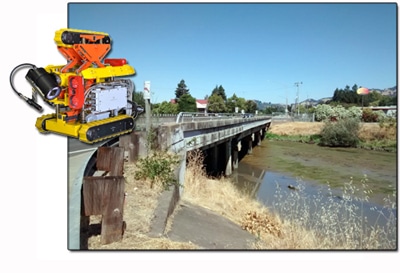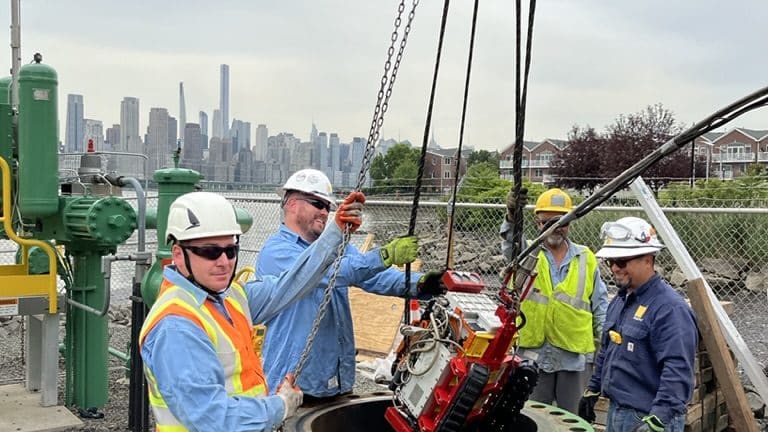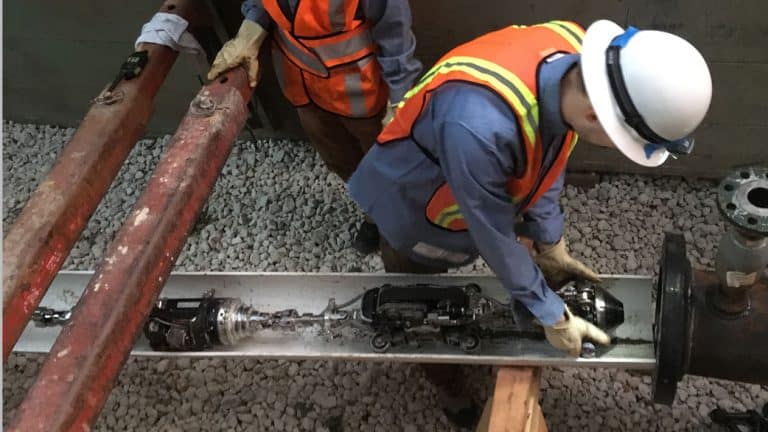Diakont was commissioned to assess the integrity of three major North American large diameter natural gas pipelines that crossed beneath rivers. The pipelines had multiple bends and low-flow, making them ‘unpiggable’ using traditional in-line inspection (ILI) methods. They also required the use of a tethered device to guarantee a successful retrieval. Each pipeline inspection case had unique characteristics that required specialized robotic solutions. The following sections provide details for each case study.
Challenge
- Assess the integrity of three major North American large-diameter natural gas pipelines that crossed beneath rivers.
- The pipelines had multiple bends and low-flow, making them ‘unpiggable’ using traditional in-line inspection (ILI) methods and required specialized robotic solutions.
Solution
- Utilize a variety of Diakont’s robotic ILI crawlers that were equipped with specific features specifically selected for each pipeline’s environment.
Result
- All three pipelines were able to be put back into service after inspection, some resulting in minor metal loss therefore documented for monitoring degradation.
Mississippi River Crossing

Diakont was commissioned by the pipeline operator to further investigate an anomaly previously found by a traditional in-line inspection. The 18” natural gas steel pipeline ran beneath the Mississippi River and had a known dent that was detected by a flow-driven smart pig. Unfortunately the downward angle of the pipeline caused a speed surge of the pig run and the details of the dent’s location and characteristics were unknown. Diakont selected an 18” robotic crawler to inspect the pipeline. Diakont hand loaded the robotic ILI crawler into the pipe via a removed spool near the edge of the river. The inspection team drove the crawler beneath the river crossing and identified the dent at 1,170 feet in the pipe. The inspection team then used EMAT NDE sensors to characterize the dent and verify the actual pipe wall thickness. The NDE scan revealed that there was 0.03” metal loss on the OD of the pipe at the location of the dent. The remaining wall thickness was within the allowable operating limits for the pipe section and the line was put back into service.
Passaic River Crossing

Diakont was commissioned to inspect a multi-diameter pipeline that traversed beneath the Passaic River and a railroad track. The natural gas steel pipeline had a diameter of 26” at the beginning then expanded to 30” half way through the line. The total inspection distance was 1,500 feet and contained multiple bends. To handle these inspection requirements, Diakont used a multi-diameter robotic ILI crawler equipped with three track systems connected to actuation systems. After scanning through the first section of the pipeline, inspection technicians raised the crawler tracks to accommodate the 30” pipeline diameter. The inspection revealed three areas of external corrosion with minor metal loss. These sections were documented for monitoring degradation over time and the pipeline was put back into service.
Novato Creek Crossing

Diakont was commissioned to inspect two pipelines that ran beneath the Novato Creek. The two lines, with diameters of 16” and 20”, were natural gas steel pipelines that contained extreme geometries including 90° bends, back-to-back bends, and vertical sections. The lines were also constructed with thicker than normal pipes which required a unique NDE assessment technology. Diakont selected two robotic crawlers to handle the inspection project. Each crawler had track systems equipped with actuation systems that pressed the tracks into the ID of the pipeline to provide the traction required for bends and verticals. Using high-power EMAT sensor suites, Diakont’s robotic ILI crawlers inspected the entirety of both lines. The inspections revealed that both pipelines were in good condition with only two minor anomalies. The pipelines were put back into service following the inspection.



